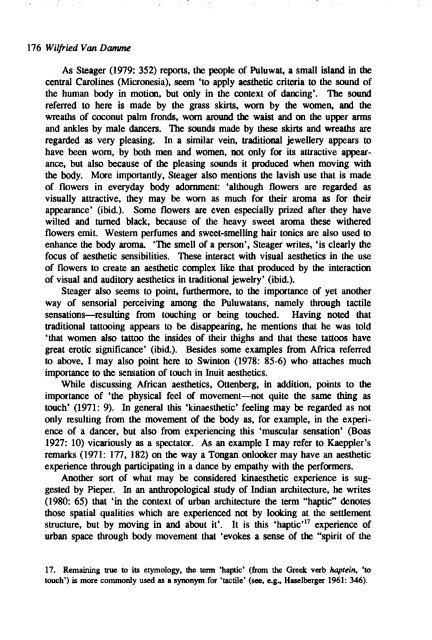1991 No. 1 CONTENTS - Institute of Social and Cultural ...
1991 No. 1 CONTENTS - Institute of Social and Cultural ...
1991 No. 1 CONTENTS - Institute of Social and Cultural ...
Create successful ePaper yourself
Turn your PDF publications into a flip-book with our unique Google optimized e-Paper software.
176 Wilfried Van Damme<br />
As Steager (1979: 352) reports, the people <strong>of</strong> Puluwat, a small isl<strong>and</strong> in the<br />
central Carolines (Micronesia), seem 'to apply aesthetic criteria to the sound <strong>of</strong><br />
the human body in motion, but only in the context <strong>of</strong> dancing'. The sound<br />
referred to here is made by the grass skirts, worn by the women, <strong>and</strong> the<br />
wreaths <strong>of</strong> coconut palm fronds, worn around the waist <strong>and</strong> on the upper anns<br />
<strong>and</strong> ankles by male dancers. The sounds made by these skirts <strong>and</strong> wreaths are<br />
regarded as very pleasing. In a similar vein, traditional jewellery appears to<br />
have been worn, by both men <strong>and</strong> women, not only for its attractive appearance,<br />
but also because <strong>of</strong> the pleasing sounds it produced when moving with<br />
the body. More importantly, Steager also mentions the lavish use that is made<br />
<strong>of</strong> flowers in everyday body adornment: 'although flowers are regarded as<br />
visually attractive, they may be worn as much for their aroma as for their<br />
appearance' (ibid.). Some flowers are even especially prized after they have<br />
wilted <strong>and</strong> turned black, because <strong>of</strong> the heavy sweet aroma these withered<br />
flowers emit. Western perfumes <strong>and</strong> sweet-smelling hair tonics are also used to<br />
enhance the body aroma. 'The smell <strong>of</strong> a person', Steager writes, 'is clearly the<br />
focus <strong>of</strong> aesthetic sensibilities. These interact with visual aesthetics in the use<br />
<strong>of</strong> flowers to create an aesthetic complex like that produced by the interaction<br />
<strong>of</strong> visual <strong>and</strong> auditory aesthetics in traditional jewelry' (ibid.).<br />
Steager also seems to point, furthermore, to the importance <strong>of</strong> yet another<br />
way <strong>of</strong> sensorial perceiving among the Puluwatans, namely through tactile<br />
sensations-resulting from touching or being touched. Having noted that<br />
traditional tattooing appears to be disappearing, he mentions that he was told<br />
'that women also tattoo the insides <strong>of</strong> their thighs <strong>and</strong> that these tattoos have<br />
great erotic significance' (ibid.). Besides some examples from Africa referred<br />
to above, I may also point here to Swinton (1978: 85-6) who attaches much<br />
importance to the sensation <strong>of</strong> touch in Inuit aesthetics.<br />
While discussing African aesthetics, Ottenberg, in addition, points to the<br />
importance <strong>of</strong> 'the physical feel <strong>of</strong> movement-not quite the same thing as<br />
touch' (1971: 9). In general this 'kinaesthetic' feeling may be regarded as not<br />
only resulting from the movement <strong>of</strong> the body as, for example, in the experience<br />
<strong>of</strong> a dancer, but also from experiencing this 'muscular sensation' (Boas<br />
1927: 10) vicariously as a spectator. As an example I may refer to Kaeppler's<br />
remarks (1971: 177, 182) on the way a Tongan onlooker may have an aesthetic<br />
experience through participating in a dance by empathy with the performers.<br />
Another sort <strong>of</strong> what may be considered kinaesthetic experience is suggested<br />
by Pieper. In an anthropological study <strong>of</strong> Indian architecture, he writes<br />
(1980: 65) that 'in the context <strong>of</strong> urban architecture the term "haptic" denotes<br />
those spatial qualities which are experienced not by looking at the settlement<br />
structure, but by moving in <strong>and</strong> about it'. It is this 'haptic,l7 experience <strong>of</strong><br />
urban space through body movement that 'evokes a sense <strong>of</strong> the "spirit <strong>of</strong> the<br />
17. Remaining true to its etymology, the tenn 'haptic' (from the Greek verb haptein, 'to<br />
touch') is more commonly used as a synonym for 'tactile' (see, e.g., Haselberger 1961: 346).
















